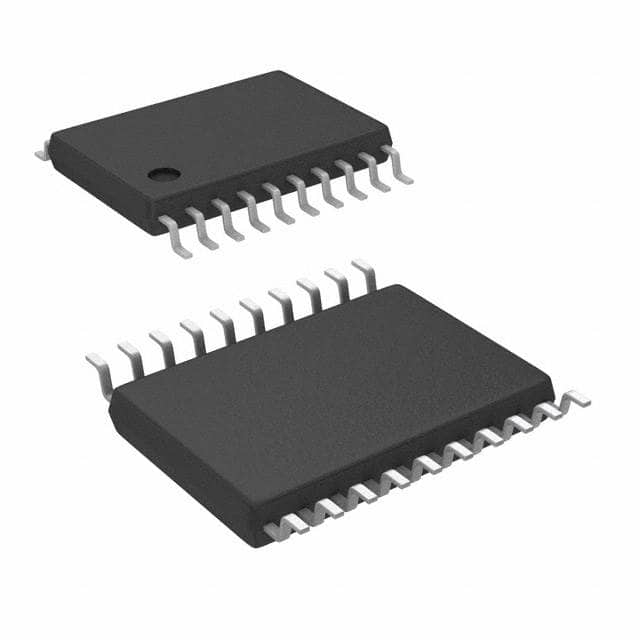Xem thông số kỹ thuật để biết chi tiết sản phẩm.

74LCX240TTR
Product Overview
Category
The 74LCX240TTR belongs to the category of integrated circuits (ICs).
Use
This IC is commonly used for signal amplification and switching purposes in electronic devices.
Characteristics
- Low voltage operation: The 74LCX240TTR operates at a low voltage, making it suitable for battery-powered devices.
- High-speed performance: This IC offers fast switching speeds, enabling efficient data transmission.
- Low power consumption: It consumes minimal power, making it energy-efficient.
- Wide operating temperature range: The 74LCX240TTR can operate reliably across a wide temperature range.
Package
The 74LCX240TTR is available in a small outline transistor (SOT) package.
Essence
The essence of the 74LCX240TTR lies in its ability to amplify and switch signals effectively, ensuring reliable data transmission.
Packaging/Quantity
This IC is typically packaged in reels or tubes, with a quantity of 2500 units per reel/tube.
Specifications
- Supply Voltage: 1.65V to 3.6V
- Input/Output Voltage Range: 0V to VCC
- Operating Temperature Range: -40°C to +85°C
- Maximum Propagation Delay: 5.5ns
- Maximum Output Current: ±24mA
Detailed Pin Configuration
The 74LCX240TTR has a total of 20 pins, which are assigned specific functions as follows:
- A1: Input pin for data signal A1.
- Y1: Output pin for amplified/switched data signal Y1.
- GND: Ground reference pin.
- A2: Input pin for data signal A2.
- Y2: Output pin for amplified/switched data signal Y2.
- A3: Input pin for data signal A3.
- Y3: Output pin for amplified/switched data signal Y3.
- OE: Output Enable pin to control the output state.
- GND: Ground reference pin.
- Y4: Output pin for amplified/switched data signal Y4.
- A4: Input pin for data signal A4.
- Y5: Output pin for amplified/switched data signal Y5.
- A5: Input pin for data signal A5.
- Y6: Output pin for amplified/switched data signal Y6.
- VCC: Power supply pin.
- A6: Input pin for data signal A6.
- Y7: Output pin for amplified/switched data signal Y7.
- A7: Input pin for data signal A7.
- Y8: Output pin for amplified/switched data signal Y8.
- GND: Ground reference pin.
Functional Features
- Signal amplification: The 74LCX240TTR amplifies weak input signals, enhancing their strength for further processing.
- Signal switching: It allows for the seamless switching of signals between different components or circuits.
- Output enable control: The OE pin enables or disables the output, providing flexibility in managing signal flow.
Advantages and Disadvantages
Advantages
- Low voltage operation makes it suitable for portable devices.
- High-speed performance ensures efficient data transmission.
- Low power consumption contributes to energy efficiency.
- Wide operating temperature range enhances reliability.
Disadvantages
- Limited output current may restrict its use in certain applications requiring higher current levels.
- Sensitive to electrostatic discharge (ESD), necessitating proper handling during installation.
Working Principles
The 74LCX240TTR operates based on complementary metal-oxide-semiconductor (CMOS) technology. It utilizes a combination of transistors and logic gates to amplify and switch signals. When an input signal is received, the IC amplifies it and routes it to the appropriate output pin based on the control signals provided.
Detailed Application Field Plans
The 74LCX240TTR finds applications in various electronic devices and systems, including but not limited to: - Mobile phones - Tablets - Personal computers - Automotive electronics - Industrial automation systems - Consumer electronics
Detailed and Complete Alternative Models
Some alternative models that offer similar functionality to the 74LCX240TTR are: - 74HC240: This IC operates at higher voltage levels but provides comparable amplification and switching capabilities. - 74ACT240: It offers faster switching speeds but requires a higher supply voltage. - 74LS240: This IC operates at lower speeds but can handle higher output currents.
These alternative models can be considered based on specific application requirements and design constraints.
In conclusion, the 74LCX240TTR is a versatile integrated circuit that excels in signal amplification and switching tasks.
Liệt kê 10 câu hỏi và câu trả lời thường gặp liên quan đến ứng dụng 74LCX240TTR trong giải pháp kỹ thuật
Sure! Here are 10 common questions and answers related to the application of 74LCX240TTR in technical solutions:
Q: What is the 74LCX240TTR? A: The 74LCX240TTR is a low-voltage octal buffer/line driver with 3-state outputs, commonly used in digital logic circuits.
Q: What is the operating voltage range of the 74LCX240TTR? A: The 74LCX240TTR operates at a voltage range of 2.0V to 3.6V.
Q: How many inputs and outputs does the 74LCX240TTR have? A: The 74LCX240TTR has 8 inputs and 8 outputs.
Q: Can the 74LCX240TTR handle bidirectional data flow? A: No, the 74LCX240TTR is a unidirectional buffer, meaning it can only drive signals in one direction.
Q: What is the maximum output current of the 74LCX240TTR? A: The 74LCX240TTR can source or sink up to 24mA of current per output.
Q: Does the 74LCX240TTR have internal pull-up or pull-down resistors? A: No, the 74LCX240TTR does not have internal pull-up or pull-down resistors.
Q: Can I connect multiple 74LCX240TTR devices together? A: Yes, you can connect multiple 74LCX240TTR devices together to expand the number of inputs or outputs in your circuit.
Q: Is the 74LCX240TTR compatible with TTL logic levels? A: Yes, the 74LCX240TTR is compatible with both TTL and CMOS logic levels.
Q: What is the propagation delay of the 74LCX240TTR? A: The typical propagation delay of the 74LCX240TTR is around 3.5ns.
Q: Can I use the 74LCX240TTR in high-speed applications? A: Yes, the 74LCX240TTR is designed for high-speed operation and can be used in applications with fast switching requirements.
Please note that these answers are general and may vary depending on specific datasheet specifications or application requirements.

